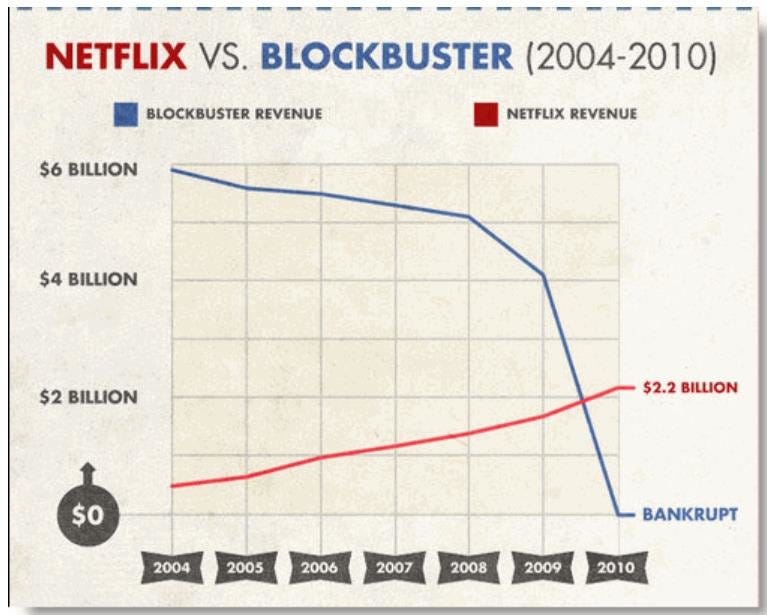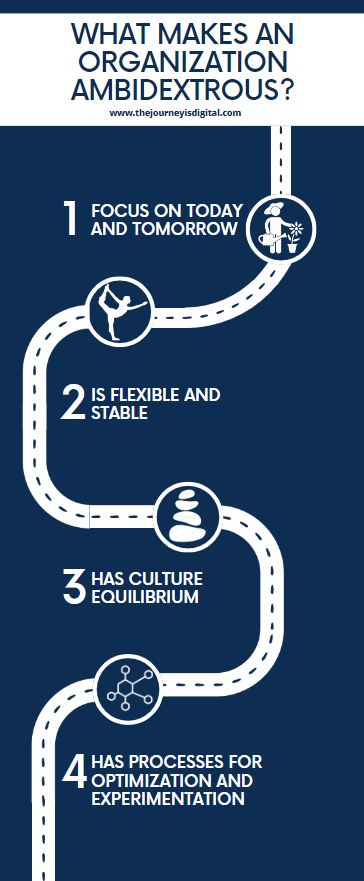Imagine you’re a gardener. You have old trees that give fruit and new seeds that could grow into trees someday. You need to take care of both. If you only focus on the old trees, you’ll have no new ones for the future. If you only care for the seeds, you’ll miss the fruit you could have now. This post will explore why this balance is crucial and how to achieve it.
The Need for Ambidexterity
Imagine only caring for your old fruit trees and not planting new seeds. You’d have fruit now, but your garden would be empty in the future. The same goes for business. If you only focus on what you’re good at today, you risk falling behind tomorrow.
Take Blockbuster as an example. They were great at video rentals but ignored the rise of online streaming. They went out of business because they didn’t adapt.

Being good at current tasks and planning for the future isn’t optional; it’s a must. It keeps your business strong today and ready for what comes next.
What Makes an Organization Ambidextrous?
What’s the recipe for a business that can balance caring for today while preparing for tomorrow? Let’s look at the key ingredients.
Focus on Today and Tomorrow
Just as a gardener spends time and effort on the old and new plants, an ambidextrous organization invests in what they’re doing now and plans for what they’ll do in the future. It’s about ensuring the business stays strong today and preparing for what will happen tomorrow.
Flexibility and Stability
You must be flexible enough to try new things and have stable systems to keep daily operations running smoothly. It’s like having a set menu and offering daily specials to test customer preferences.
Culture and Mindset Matters
The culture of an ambidextrous organization should foster a dynamic equilibrium between exploiting existing strengths and exploring new horizons. It values innovation, encourages continuous learning and collaboration, and instills agility and customer-centricity as core principles.
Processes and Structure
Steve Blank highlights the challenges large corporations face when trying to innovate. Established firms have processes and cultures optimized for executing existing business models but are often ill-equipped for the chaos and uncertainty of disruptive innovation.
For corporations to innovate successfully, they need to create structures that allow them to explore new opportunities without threatening their core business. This is the essence of being ambidextrous. The idea is that corporations must separate their exploratory units (those seeking disruptive innovations) from their execution units (those focused on the core business) and maintain tight links between them.

An ambidextrous organization is one that can operate its current business model efficiently (exploiting current opportunities) while also exploring new business models or innovations (exploring new opportunities).

Three Key Questions to Determine the Nature of Your Project
But how can you tell which type of project you’re working on? Understanding this can help you allocate resources more effectively and set realistic expectations. The questions below offer a quick and simple way to classify your projects.
Question 1: Is the Project About Launching Products in Markets Your Company Hasn’t Been In Before?
- Yes (Explore): The project is about entering markets or areas your company hasn’t operated.
- No (Exploit): The project aims to grow in markets where you already have a presence, even if it’s with new versions of existing products.
Question 2: Is the Project Focused on Releasing a New Version of a Product with Significant Changes in Technology, Design, or Purpose?
- Yes (Explore): If the updated product has major technological advancements, a completely new design, or serves a different purpose, then the project leans more towards exploration.
- No (Exploit): If the changes are minor and build on what’s already in place, then the project is likely about exploitation.
Question 3: Are You Using Business Models You’ve Used Before
- Yes (Exploit): The project sticks to business models and practices your company already knows well, including familiar pricing strategies and customer segments.
- No (Explore): This project involves experimenting with new business practices, such as introducing a new pricing model or aiming for a different target customer segment, even if the product isn’t new.
Sometimes, the results from the questions are clear-cut, pointing clearly toward either an “Explore” or “Exploit” project. However, it’s pretty common to end up with mixed results that don’t make it so easy to label your project.
If you find that your answers are a mix of “Explore” and “Exploit,” don’t worry; you’re not alone. It’s common, especially in projects aiming to introduce new versions of existing products or services. In such cases, your project can be termed an “ambidextrous” project. This means your project is a blend of exploration—such as introducing new features or technology—and exploitation.
Explore vs. Exploit—What’s the Difference?
You’ll gain two key advantages by comparing “explore” and “exploit” strategies from various perspectives like purpose and environment. First, you’ll understand your project’s alignment more clearly, whether it’s about fine-tuning what you already do or branching out into new areas. Second, this understanding can directly influence the effectiveness of your strategic decisions, both now and in the future.
Exploit (Current Opportunities)
Purpose
Short and Mid-Term Impact: Success is gauged by immediate returns, such as quarterly or yearly profits. Learning is geared toward refining existing skills and capabilities. Focus on process and management innovation.
Innovation
Optimization of Existing Portfolio: The key here is fine-tuning existing products or services to improve performance and profitability.
Culture
Quality and Efficiency-Oriented: A culture that values doing things right the first time, focusing on short-term gains and efficiency.
Environment
Stability and Reliability: The emphasis is on maintaining consistent and reliable processes that ensure smooth daily operations.
Explore (New Opportunities)
Purpose
Success is gauged by long-term impact and the learning acquired. Metrics might include new product launches, while workforce upskilling and organizational capabilities development are continual goals. Focus on product and business model innovation.
Innovation
Emphasis on Experiments and New Ventures: Exploration thrives on trial and error. A pipeline of new experiments provides the data and insights needed for innovation.
Culture
Innovative and Risk-Oriented: Here, the emphasis is on taking calculated risks and fostering creativity. A supportive environment makes it easier for teams to venture into new territories and think outside the box.
Environment
Agility and Flexibility are key. Agility allows the organization to adapt quickly to new information, whether an unexpected obstacle or a promising opportunity.
Challenges and How to Overcome Them
No good thing comes without challenges, and the journey to ambidexterity is no exception. Here, we’ll explore some common obstacles organizations face on this path and provide strategies to overcome them.
Cultural Clash
Shifting from a well-established culture of efficiency to one of innovation can create resistance and confusion among employees. Foster a culture that values both efficiency and innovation. Encourage open communication and provide clear guidelines on when to explore and when to exploit.
Resource Allocation
Allocating resources for exploration can be challenging when there’s pressure to deliver short-term results. Create a dedicated budget for exploration initiatives. This ensures that innovation efforts are adequately funded without compromising core operations.
Risk Aversion
Fear of failure can stifle exploration. Employees may hesitate to take risks, which are inherent in innovation. Promote a safe environment for experimentation. Celebrate failures as learning opportunities, and reward calculated risks that lead to breakthroughs.
Communication Gap
Departments working on exploration and exploitation may operate in silos, leading to a lack of coordination. Establish clear channels for communication and collaboration between teams. Regular meetings, cross-functional teams, and shared goals can bridge the gap.
Leadership Alignment
Challenge: Leadership teams may not be aligned in their vision for ambidexterity, leading to mixed messages and conflicting priorities.
Ensure that top leadership is on the same page regarding the importance of ambidexterity. Define clear roles and responsibilities for each aspect and create a shared vision.
Conclusion
In today’s fast-changing business world, being ambidextrous is vital. It means balancing current success with future readiness. This requires fostering a culture that values efficiency and innovation, smart resource allocation, and encouraging experimentation. Yet, challenges like cultural differences arise. To succeed, organizations must tackle these challenges strategically.





